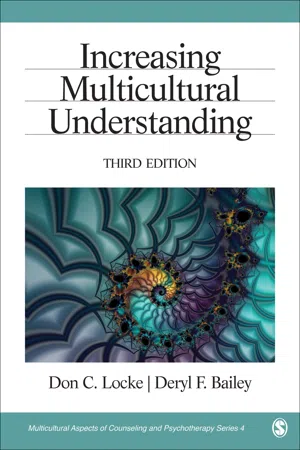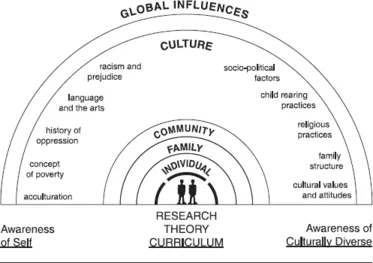
- 352 pages
- English
- ePUB (mobile friendly)
- Available on iOS & Android
eBook - ePub
Increasing Multicultural Understanding
About this book
Increasing Multicultural Understanding, Third Edition provides the necessary tools to foster positive and productive relationships among culturally diverse populations. Authors Don C. Locke and Deryl F. Bailey encourage readers to explore their own cultural background and identity, and in the process, begin to better understand others. A best-seller in the first and second editions, this revised and expanded third edition continues to present its classic framework for critical observation with at least 10 elements, including: the history of oppression, religious practices, family structure, degree of acculturation, poverty, language and the arts, racism and prejudice, sociopolitical factors, child-rearing practices, and values and attitudes.
Frequently asked questions
Yes, you can cancel anytime from the Subscription tab in your account settings on the Perlego website. Your subscription will stay active until the end of your current billing period. Learn how to cancel your subscription.
No, books cannot be downloaded as external files, such as PDFs, for use outside of Perlego. However, you can download books within the Perlego app for offline reading on mobile or tablet. Learn more here.
Perlego offers two plans: Essential and Complete
- Essential is ideal for learners and professionals who enjoy exploring a wide range of subjects. Access the Essential Library with 800,000+ trusted titles and best-sellers across business, personal growth, and the humanities. Includes unlimited reading time and Standard Read Aloud voice.
- Complete: Perfect for advanced learners and researchers needing full, unrestricted access. Unlock 1.4M+ books across hundreds of subjects, including academic and specialized titles. The Complete Plan also includes advanced features like Premium Read Aloud and Research Assistant.
We are an online textbook subscription service, where you can get access to an entire online library for less than the price of a single book per month. With over 1 million books across 1000+ topics, we’ve got you covered! Learn more here.
Look out for the read-aloud symbol on your next book to see if you can listen to it. The read-aloud tool reads text aloud for you, highlighting the text as it is being read. You can pause it, speed it up and slow it down. Learn more here.
Yes! You can use the Perlego app on both iOS or Android devices to read anytime, anywhere — even offline. Perfect for commutes or when you’re on the go.
Please note we cannot support devices running on iOS 13 and Android 7 or earlier. Learn more about using the app.
Please note we cannot support devices running on iOS 13 and Android 7 or earlier. Learn more about using the app.
Yes, you can access Increasing Multicultural Understanding by Don C. Locke,Deryl F. Bailey in PDF and/or ePUB format, as well as other popular books in Psychology & Education Counseling. We have over one million books available in our catalogue for you to explore.
Information
1 A Model of Multicultural Understanding
The model of multicultural understanding presented in this volume is a comprehensive model that can be used as a guide to gain knowledge and understanding of culturally diverse individuals and groups. This knowledge and understanding can then be reflected appropriately in educational and counseling situations. The four primary axes along which hierarchies are established in all societies are class, race, gender, and age. The model was designed to include all the elements of personal awareness and information necessary for a person to engage in positive and productive relationships with culturally diverse individuals or groups. It is useful for teachers, individual counselors, family counselors, and those involved in any intervention within culturally diverse communities.
The model (Figure 1.1) provides a solid, sound foundation for exploring ethnic differences. Moreover, we are interested in how representations of ethnicity provide the meanings and symbols that organize educational and counseling practice. While thorough and comprehensive, this model is succinct enough to be useful in examining the cultural patterns, social relationships, and experiences of culturally diverse individuals and groups.
Self-Awareness
One uses the model by beginning with self-awareness. This component refers to the traditional “know thyself” element of Greek philosophy. In helping relationships with the culturally diverse it might be necessary and useful for those involved to share their personal experiences as well as their worldview. Worldview means contemplation of the world or a view of life. It connotes a personal theory composed of knowledge and beliefs about the meaning of the world. Knowing one’s own personal biases, values, interests, and worldview—which stem from culture—as well as knowing one’s own culture will greatly enhance one’s sensitivity toward other cultures. Awareness of self is the first step to understanding others (Locke, 1996; Grimmett, Locke, Rowley, & Spencer, 2011); in seeking that awareness, one might attempt to answer the following questions:
Figure 1.1 Multicultural Understanding

- What is your ethnic identity?
- Which cultural memberships are most influential in the way you define yourself? What was the culture of your parents and grandparents?
- What privileges do your cultural memberships afford you?
- What is my worldview?
- What is the cultural relevance of my name?
- What values, beliefs, opinions, and attitudes do you hold that are consistent with the dominant culture? Which are inconsistent? How did you learn these? Look specifically at your spiritual beliefs, the origin of these beliefs, and how these beliefs influence your choices and behaviors.
- How did you decide to become a teacher or counselor? What cultural standards were involved in the process? What do you understand to be the relationship between culture and education or counseling?
- What unique abilities, aspirations, expectations, and limitations do you have that might influence your relations with culturally diverse individuals?
Howell (1982) describes levels of communication competence that help educators and counselors reflect on where they may be functioning in any situation. In The Empathic Communicator, he explains how learners transition from one level to the next. Individuals at Level 1 (unconscious incompetence) do not recognize that they are miscommunicating. As they move into Level 2 (conscious incompetence), counselors and educators recognize their mistakes, but they are generally unable to correct or resolve the problem. The third level (conscious competence) adds understanding, that is, knowing what you do and why it works or does not work. The fourth level (unconscious competence) and fifth level (unconscious super competence) are where experts’ function and skillful interaction appear effortless. Experts are able to modify their interactions with others as needed without thinking about them.
Global Influences
What happens in our world today often becomes more meaningful if where it happens has some relevance at a personal level. The culturally sensitive individual must be cognizant of world events and how members of various cultures translate those events into personal meaning. The world is becoming smaller and smaller, and events in a cultural group’s country of origin may produce significant emotional reactions in group members. Some culturally diverse individuals may have relatives who still live in their countries of origin and may be quite sensitive to events in those countries, the policies of the U.S. government toward those events, and the attitudes of helpers toward the events. Such interest on the part of culturally diverse individuals necessitates some knowledge of world affairs. Shifts in the economic and political scenes in the United States greatly influence the state of affairs in South America, Africa, and Asia. Knowledge of the culture in a client’s country of origin provides the helper with a more complete picture of that client’s worldview.
Dominant Culture
This model uses the general culture of the United States as the backdrop for understanding culturally diverse individuals and groups. The model is useful in any setting where there are two reasonably different cultural groups. It seems appropriate for teachers and counselors to have a fairly clear knowledge of the values of the dominant culture.
Culture is not a thing, a possession, or even a legacy. Culture is a process of continuous exploration, discovery, and creation. Culture is a construct that captures a socially transmitted system of ideas—ideas that shape behavior, categorize perceptions, and give names to selected aspects of experience. The primary mode of transmission of culture is language, which enables people to learn, experience, and share their traditions and customs. Hughes (1976) formulated a definition of culture which presents it as
a learned configuration of images and other symbolic elements widely shared among members of a given society or social group which, for individuals, functions as an orientation framework for behavior, and, for the group, serves as the communicational matrix which tends to coordinate and sanction behavior. (p. 13)
Thus, the cultural process is a means for conveying values across generations. Cassirer (1944) described the symbolic system as unique to humans when he pointed out that humans
live not merely in a broader reality . . . but lives, so to speak in a new dimension of reality . . . [humans] cannot escape their own achievement. [Humans] cannot but adapt the conditions of life. [Humans] live in a symbolic universe. (pp. 42–43)
The root concept for the term ethnicity is culture. Ethnicity is a derivative concept that recognizes the in-group values conceptualized by a particular cultural group, such as African Americans, Jewish Americans, or Vietnamese in the United States. Ethnic identity is measured by self- perception, identification, and participation in ethnic activities. Thus, culture and ethnicity refer to the same generic processes.
Nash (1989) has reduced the core elements of ethnicity to three: kinship, commensality (e.g., food preferences, lifestyle), and the shared ideology he calls a common cult (body of beliefs and ritual activities that celebrate the community’s historical experience). The essence of ethnicity is contrast, the recognition of difference. Alba (1990) categorized theories of ethnic identity into four types: ethnicity as class, for example, working class; as a political movement, for example, power movements of the 1960s; as revival, for example, ethnic foods, clothing, festivals; and as a token identity, for example, passing down a Swedish cookie recipe.
Steward (1972) identifies five components of culture in his summary of cultural assumptions and values:
- Activity: How do people approach activity? How important are goals in life? Who makes decisions? What is the nature of problem solving?
- Definition of social relations: How are roles defined? How do people relate to those whose status is different? How are sex roles defined? What is the meaning of friendship?
- Motivation: What is the achievement orientation of the culture? Is cooperation or competition emphasized?
- Perception of the world: What is the predominant worldview? What is the predominant view on human nature? What is the predominant view on the nature of truth? How is time defined? What is the nature of prope...
Table of contents
- Cover
- Half Title
- Multicultural Aspects of Counseling and Psychotherapy Series
- Title Page
- Copyright Page
- Brief Contents
- Detailed Contents
- Acknowledgments
- Introduction
- 1 A Model of Multicultural Understanding
- 2 Native American Indians
- 3 Mexican Americans
- 4 Puerto Rican Americans
- 5 African Americans
- 6 Chinese Americans
- 7 Japanese Americans
- 8 Korean Americans
- 9 Vietnamese in the United States
- 10 Jewishness in America
- 11 Muslims in the United States
- 12 Social Justice in Education and Counseling
- Epilogue
- References
- Author Index
- Index
- About the Authors